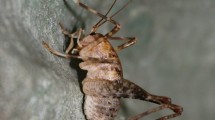Summary
The vibrational sensitivity of awake pigeons was tested with the heart rate conditioning method. This method proved to be a very sensitive instrument for the behavioural measurement of the pigeon's sensitivity to mechanical stimuli.
Sine wave vibrational stimuli between 50 and 2000 Hz were applied to the 1st, 7th and 16th primary feathers of the wing. The resulting threshold curves were U- or V-shaped with 3 characteristics: (i) The frequency of best response was either 800 or 900 Hz. (ii) Within the broad frequency range of vibrational sensitivity (50 to 2000 Hz) the sensitivity was extremely high at the best frequency: threshold amplitudes lay between 0.5 and 0.09 μm. (iii) The threshold curves showed very sharp tuning at best frequency with bandwidths between 0.3 and 0.7 octaves (measured at best frequency 10fold above threshold). The functional meaning of the characteristic vibrational sensitivity of the wing for flight control is discussed; it is interpreted as an adaptation to special situations occurring during flight.
Similar content being viewed by others
Abbreviations
- CR :
-
conditioned response
- CS :
-
conditioned stimulus
- ECG :
-
electrocardiogram
- HC(s):
-
Herbst corpuscle(s)
- UCS :
-
unconditioned stimulus
References
Beaugrand JP (1976) An attempt to confirm magnetic sensitivity in the pigeon (Columba livia). J Comp Physiol 110:343–355
Bräucker R (1981) Versuche zum Unterscheidungslernen rhythmisch strukturierter akustischer Signale bei Tauben. Master's thesis, Bochum
Delius JD, Tarpy RM (1974) Stimulus control of heart rate by auditory frequency and auditory pattern in pigeons. J Exp Anal Behav 21:297–306
Cohen DH, Durkovic RG (1966) Cardiac and respiratory conditioning, differentiation, and extinction in the pigeon. J Exp Anal Behav 9:681–688
Gewecke M, Woike M (1978) Breast feathers as an air-current sense organ for the control of flight behaviour in a songbird (Carduelis spinus). Z Tierpsychol 47:293–298
Goerdel-Leich A, Schwartzkopff J (1984) The auditory threshold of the pigeon (Columba livia) by heart-rate conditioning. Naturwissenschaften 71:98–99
Goodwin AW, John KT, Darian-Smith I (1989) Skin profiles during siunusoidal vibration of the finger pad. Exp Brain Res 77:79–86
Gottschaldt KM (1974) The physiological basis of tactile sensibility in the beak of geese. J Comp Physiol 95:29–47
Hörster W (1990) Histological and electrophysiological investigations on the vibration-sensitive receptors (Herbst corpuscles) in the wing of the pigeon (Columba livia). J Comp Physiol A 166:663–673
Hörster W, Shen J, Schwartzkopff J (1983) Electrophysiological studies on the vibrational sensitivity in the pigeon. Naturwissenschaften 70:151–152
Keidel WD (1984) The sensory detection of vibrations. In: Dawson WW, Enoch JM (eds) Foundations of sensory science. Springer, Berlin Heidelberg New York Tokyo, pp 465–512
Kühn A, Müller CM, Leppelsack H-J, Schwartzkopff J (1982) Heart-rate conditioning used for determination of auditory threshold in the starling. Naturwissenschaften 69:245–246
Nachtigall W (1985) Warum Vögel fliegen. Rasch und Röhring, Hamburg Zürich, pp 189–191
Necker R (1983) Somatosensory system. In: Abs M (ed) Physiology and behaviour of the pigeon. Academic Press, London, pp 171–192
Necker R (1985) Receptors in the wing of the pigeon and their possible role in bird flight. In: Nachtigall W (ed) Biona Rep 3: Vogelflug. Fischer, Stuttgart New York, pp 433–444
Schwartzkopff J (1949) Über Sitz und Leistung von Gehör und Vibrationssinn bei Vögeln. Z Vergl Physiol 31:527–608
Shen J (1983) A behavioral study of vibrational sensitivity in the pigeon (Columba livia). J Comp Physiol 152:251–255
Shen J, Hörster W, Schwartzkopff J (1983) Vibrational sensitivity in the pigeon as measured by heart-rate conditioning. Naturwissenschaften 70:48–49
Wallraff HG (1968) Über das Orientierungsvermögen von Vögeln unter natürlichen und künstlichen Sternenmustern. Dressurversuche mit Stockenten. Verh Dtsch Zool Ges Innsbruck: 347–357
Author information
Authors and Affiliations
Additional information
All experiments were carried out at the Ruhr-Universität Bochum, Lehrstuhl für Allgemeine Zoologie
Rights and permissions
About this article
Cite this article
Hörster, W. Vibrational sensitivity of the wing of the pigeon (Columba livia) — a study using heart rate conditioning. J Comp Physiol A 167, 545–549 (1990). https://doi.org/10.1007/BF00190825
Accepted:
Issue Date:
DOI: https://doi.org/10.1007/BF00190825




